
Why Acceptance Feels Like Everything
There are many things CPTSD makes harder than they should be. For me, one of the big ones is my need to be accepted, not necessarily liked. I get that people will either like me or not. What I really want is to be accepted for who I am, and especially once you understand my past. To prove that I’m worthy and, deep down, wanted. To know that the thing that shaped me doesn’t make me unlovable.
Facing the Hard Truth at the Start of Healing
It’s not an easy thing to admit when you’re just in the beginning stages of healing. But once you do the work, you begin to notice the patterns, the stuff inside you that pops out, the things you’ve been carrying around for years without even realizing it.
And because we’re human, we seek out that acceptance in other people, in our relationships, in how others respond to us. And for a while, that feels like it works. But it’s only a Band-Aid. Because when those relationships end, it rips the wound back open and makes every belief you’ve carried about being unworthy feel true all over again. It’s only when you start healing that you realize external acceptance was never going to fix the internal scars. (here’s why self-validation matters after childhood trauma).
When Abuse Wires Your Brain to Believe the Worst
When those thoughts are planted in you young, especially through sexual abuse, your brain learns to believe the worst. It gets conditioned to think that if someone can’t accept you or doesn’t want you, it must be because of the abuse. That you are unworthy.
And it’s not just insecurity; it’s something much deeper, etched into the way you see yourself and the world around you.
Insecurity vs. The CPTSD Core Belief
You see, being insecure means you look at yourself, see the flaws, and think, “Nobody is going to want me looking like this.”
But the wiring from abuse, trauma, and CPTSD runs deeper. It’s not just about how you look; it convinces you that you’re broken at the core. That no matter what you do, no matter how much you change or try to prove your worth, you’ll never truly be wanted. It shapes every interaction, every connection, until it feels less like a thought and more like something ingrained into your DNA.
Learning the Truth After Years of Fighting
With all that, here’s what I’ve learned after years of fighting that belief: it’s nothing but a lie that CPTSD told me. But It feels like the truth because it was seared into me so young, but it’s not who I really am.
And then there are moments, small ones at first, where someone does see me. Not the mask I used to wear, or the version of me trying to prove my worth, just me. And they stay. They don’t run. And they don’t see “broken.”
Every time that happens, it rewires something inside me, just a little. It’s proof that what happened to me doesn’t get to define me forever. That I am not unlovable; I never was.
The Real Meaning of Healing
What it comes down to is that, healing isn’t about becoming someone worthy of love; it’s about finally seeing that you always were.
It’s taken me many decades just to begin believing that. And sure, I still don’t have it all figured out. But I do know this: I’m more forgiving of myself and more accepting than I ever was before. And that, right there, is progress.
If any of this hits home, know you’re not alone. Healing takes time, and it’s totally okay to mess up along the way. If you ever want to share your story or just chat, I’m here.
Photo by GreenForce Staffing on Unsplash
